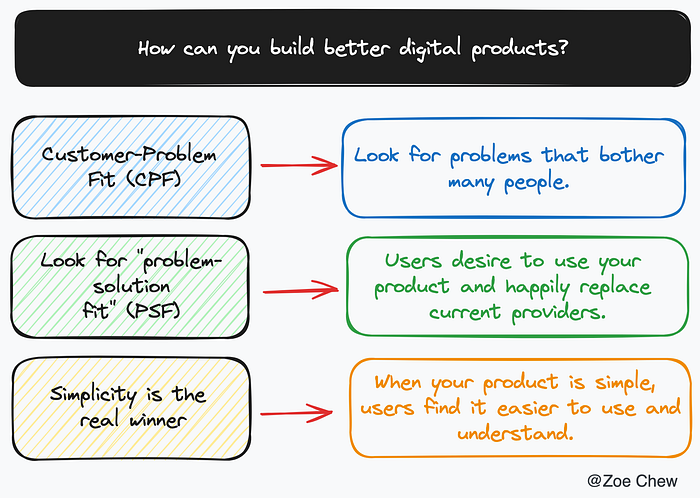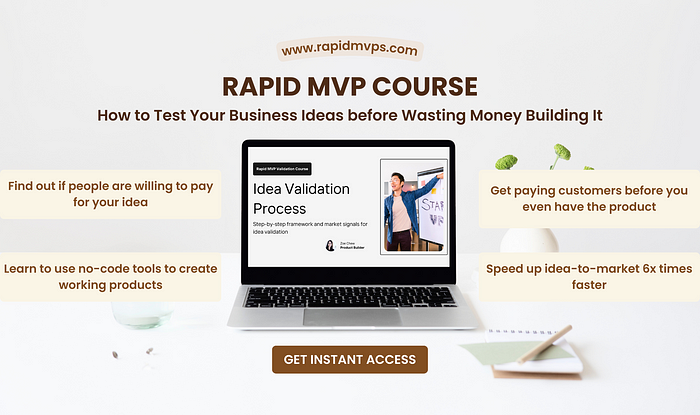I break down product-building lessons to help tech builders create better Internet products. This post is one of my Multi-Part Product Guide series. You may also like my top-rated guides such as — Profitable SaaS Ideas, Minimum Viable Market, and MVP Experiments For Your Startup

Lesson #1: Understand the Problem
Your startup or business can only exist sustainably if there is a real problem that your solution can address.
Ask yourself: What problem are your potential customers facing?
Break it down into specific pain points, frustrations, challenges, or inconveniences they face.
Then, validate the problems by talking to potential customers and conducting market research.
Pro Tips:
To tell if a problem is worth solving, check it against three things:
- Look for problems that bother many people. If more people have the problem, it’s more important to solve.
- Check if people really want to solve the problem. The more people desire to get rid of their pain points, the better.
- See if the problem messes up people’s daily routines. If it causes big disruptions or troubles in everyday life, it’s important to fix it.
Lesson #2: Problem-Solution Fit
Your product will only be successful if it has a problem-solution fit.
This means that what you offer as a solution matches up well with the problem they have.
Here are three scenarios:
- Not Good: You’ve found a problem that many people have, but your solution fails to address it effectively. Imagine offering a rapid weight-loss solution that requires customers to undergo painful injections. The problem is valid, but the solution is not practical.
- Better: Your solution is effective, but it may be overly complicated for the problem it’s meant to solve.
- Best: Your solution seamlessly fits the problem, offering a user-friendly experience and delivering significant value. Users desire to use your product and happily replace current providers.
Lesson #3: Less is (Always) More
As a product builder, it’s tempting to cram your product with lots of cool features. But simplicity is often the real winner.
Simplicity means prioritizing user needs and creating features that add value. It also involves focusing on high-impact functionalities and eliminating unnecessary complexities.
Why is simplicity important?
- When your product is simple, users find it easier to use and understand. They won’t get confused or frustrated trying to figure it out. E.g. ChatGPT has a basic text-based interface that minimizes distractions.
- Keeping things simple allows you to respond quickly to user feedback. You won’t waste time managing unnecessary features, so you can make improvements faster.
- Complicated features can be expensive to build and maintain. Simplifying things helps you save money on development and ongoing maintenance.

Lesson #4: Fail Fast, Fail Forward
If you’ve ever created a product that never took off, hear me out.
You can never completely fail a product. With each failure, you’re not starting from scratch, but rather building upon past experiences that bring you closer to success.
Failing fast allows you to quickly test hypotheses, ideas, and assumptions.
By experimenting and iterating rapidly, you gain valuable insights into what works and what doesn’t. This allows you to tweak your product and strategy more effectively.
Lesson #5: Create “Lovable Products”
While beginning with a basic MVP (minimum viable product) to address user needs is practical, the goal should ultimately be to transition from MVP to MLP (minimum lovable product).
In MLP, you focus on more than just solving problems. You provide delightful experiences and emotional connections to users through feature development.
For example, Airbnb began as an online booking platform for accommodation rentals.
Now, it has evolved into a community where people can explore new places, book unique activities, connect with local hosts, and learn new skills with experts (Online Experiences).
The Ultimate Idea Validation Framework
Working on new product ideas? I’ve combined various tactics, frameworks, and processes to determine whether your product ideas have the potential to be monetized.
Click here to learn ::

